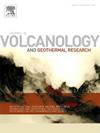The 70 ka ‘Perote Pumice’ inter-caldera dacite-rhyolite Plinian eruption of Los Humeros Volcanic Complex, Mexico: Lithostratigraphy, hazards, and eruption dynamics
IF 2.3
3区 地球科学
Q2 GEOSCIENCES, MULTIDISCIPLINARY
Journal of Volcanology and Geothermal Research
Pub Date : 2025-04-10
DOI:10.1016/j.jvolgeores.2025.108340
引用次数: 0
Abstract
Volcanic calderas span diverse eruptive styles, magnitudes, and intensities, comprising effusive/explosive activity often wrapped in between catastrophic caldera-forming episodes. During the inter-caldera stages, frequent Plinian eruptions, fueled by chemically varied magmas, pose significant hazards. The basaltic-rhyolitic Los Humeros Volcanic Complex (LHVC), Mexico's widest active caldera system, typifies such dynamics. The 70 ka Perote Pumice (PP), the largest eruption during LHVC's inter-caldera period (164–69 ka), marks a critical phase of high-intensity volcanic activity following the main caldera-collapse (164 ka). Here, we integrate lithostratigraphic mapping (52 locations) with geochemical and microtextural analyses to reconstruct the PP eruption source parameters, hazards, and dynamics. Our findings indicate that the PP deposits, comprising 13 layers (8 fallout and 5 pyroclastic density currents) reflect progression from dacite unsteady plumes and outgassed lava-plug bursts to a sustained gas-rich rhyolite-driven Plinian column, culminating in column-collapse due to waning gas and magma supply. This catastrophic VEI-6 eruption produced 30–40 km-high columns, 4.73 ± 0.18 km3 DRE, and maximum 9 × 108 ± 0.9 kg s−1, depositing pumice from proximal (∼1360 km2) to distal offshore areas (max. 200 km from the source to the Gulf of Mexico). The geochemical and microtextural data suggest that both dacite and rhyolite magmas mingled, were rapidly decompressed, and fragmented, yielding pervasive banded pumice. The refined stratigraphy, eruption parameters, and dynamics underscore PP as a benchmark for high-intensity inter-caldera volcanism. Considering LHVC's potential for future silicic activity, a PP-scale event would threaten two-million people within 140 km east and southeast of the caldera.
墨西哥Los Humeros火山杂岩70 ka“Perote浮石”破口间英安岩流纹岩普林尼期喷发:岩石地层、危险和喷发动力学
火山破火山口的喷发方式、震级和强度各不相同,在灾难性的破火山口形成事件之间,经常会出现喷涌/爆炸活动。在破火山口间阶段,频繁的普林尼火山爆发,由化学变化的岩浆推动,造成重大危害。玄武岩-流纹岩Los Humeros火山复合体(LHVC)是墨西哥最广泛的活跃火山口系统,代表了这种动力学。70 ka Perote浮石(PP)是LHVC破火山口间期(164 - 69 ka)最大的一次喷发,标志着主破火山口崩塌(164 ka)后的高强度火山活动的关键阶段。在这里,我们将岩石地层填图(52个地点)与地球化学和微结构分析相结合,重建了PP喷发源参数、危害和动力学。研究结果表明,PP矿床由13层(8层沉降流和5层火山碎屑密度流)组成,反映了从英安岩不稳定羽流和脱气熔岩塞爆发到持续的富气流纹岩驱动的普林尼期柱的过程,最终由于气体和岩浆供应的减少而导致柱崩塌。这次灾难性的VEI-6喷发产生了30-40公里高的柱,4.73±0.18 km3的DRE,最大9 × 108±0.9 kg s - 1,从近端(~ 1360 km2)到远端近海地区(最大1360 km2)沉积浮石。从源头到墨西哥湾200公里)。地球化学和微结构资料表明,英安岩和流纹岩岩浆混合,迅速减压破碎,形成普遍存在的带状浮石。精细的地层、喷发参数和动力学都强调了PP是高强度火山口间火山作用的基准。考虑到LHVC潜在的未来硅活动,pp规模的事件将威胁到火山口东部和东南部140公里范围内的200万人。
本文章由计算机程序翻译,如有差异,请以英文原文为准。
求助全文
约1分钟内获得全文
求助全文
来源期刊
CiteScore
5.90
自引率
13.80%
发文量
183
审稿时长
19.7 weeks
期刊介绍:
An international research journal with focus on volcanic and geothermal processes and their impact on the environment and society.
Submission of papers covering the following aspects of volcanology and geothermal research are encouraged:
(1) Geological aspects of volcanic systems: volcano stratigraphy, structure and tectonic influence; eruptive history; evolution of volcanic landforms; eruption style and progress; dispersal patterns of lava and ash; analysis of real-time eruption observations.
(2) Geochemical and petrological aspects of volcanic rocks: magma genesis and evolution; crystallization; volatile compositions, solubility, and degassing; volcanic petrography and textural analysis.
(3) Hydrology, geochemistry and measurement of volcanic and hydrothermal fluids: volcanic gas emissions; fumaroles and springs; crater lakes; hydrothermal mineralization.
(4) Geophysical aspects of volcanic systems: physical properties of volcanic rocks and magmas; heat flow studies; volcano seismology, geodesy and remote sensing.
(5) Computational modeling and experimental simulation of magmatic and hydrothermal processes: eruption dynamics; magma transport and storage; plume dynamics and ash dispersal; lava flow dynamics; hydrothermal fluid flow; thermodynamics of aqueous fluids and melts.
(6) Volcano hazard and risk research: hazard zonation methodology, development of forecasting tools; assessment techniques for vulnerability and impact.

 求助内容:
求助内容: 应助结果提醒方式:
应助结果提醒方式:


